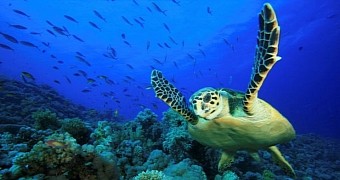Just yesterday, US leader Barack Obama announced that, come Thursday, September 25, he would use his presidential powers to create the largest marine reserve in the world.
Thus, the President wishes to grant legal protection to about 370,000 square nautical miles (approximately 490,000 square miles / 1,270,000 square kilometers) of pristine ecosystems around remote islands and atolls in the south-central Pacific Ocean.
Pumping up an already established reserve
President Barack Obama will create the world's largest marine sanctuary by expanding the already established Pacific Remote Islands Marine National Monument to about six times its current size.
Word has it that, once pumped up, this marine reserve in the Pacific Ocean will span over an area about three times the size of the state of California. The resulting monument will encompass several dozen coral reefs and seamounts.
“Expanding the Monument will more fully protect the deep coral reefs, seamounts, and marine ecosystems unique to this part of the world, which are also among the most vulnerable areas to the impacts of climate change and ocean acidification,” the White House says in a statement.
“The Administration identified expanding the Pacific Remote Islands Marine National Monument as an area of particular interest because science has shown that large marine protected areas can help rebuild biodiversity, support fish populations, and improve overall ecosystem resilience,” it adds.
What does this expansion mean?
Once the Pacific Remote Islands Marine National Monument is expanded, fishing activities and other commercial activities such as deep sea mining will be strictly off limits in the 490,000 square miles of natural ecosystems benefiting from legal protection.
The newly created marine reserve will be looked after by the Departments of the Interior and Commerce through the U.S. Fish and Wildlife Service and National Oceanic and Atmospheric Administration, respectively.
Recreational and traditional fishing will still be allowed, just as long as the people carrying out such activities prove that what they are doing does not in any way upset local marine ecosystems, the White House explains.
It is understood that, by establishing this marine sanctuary, US President Barack Obama hopes to give marine plant and animal species a chance to go about their lives without having people destroy their homes and steal their lunch on a regular basis. Millions of seabirds are expected to also benefit from the creation of this monument.
Do we really need a marine reserve of this size?
Not to smash anybody's fantasies about how all is just fine and dandy in the world, but the fact of the matter is that President Obama did well in deciding to expand the Pacific Remote Islands Marine National Monument.
Due to climate change, our planet's seas and oceans are getting warmer. Besides, carbon dioxide pollution is causing their waters to become more acidic. As a result, many aquatic plant and animal species are having trouble keeping themselves safe from extinction.
Hence, having more marine sanctuaries around can only come as good news as far as safeguarding marine biodiversity is concerned. As explained by the White House, “The expansion will better protect the habitat of animals with large migration and foraging ranges that stretch throughout the area, including sea turtles, marine mammals, and manta rays.”

 14 DAY TRIAL //
14 DAY TRIAL //